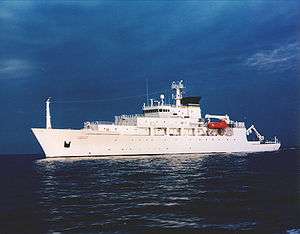USNS Bowditch (T-AGS-62)
USNS Bowditch (T-AGS 62) is a Pathfinder-class survey ship. She is the third ship in the class. Bowditch is a part of a 29 ship Special Mission Ship program and operates in the South China Sea. She is named after mathematician Nathaniel Bowditch.
 USNS Bowditch at Sea | |
| History | |
|---|---|
| Namesake: | Nathaniel Bowditch |
| Owner: | United States Navy |
| Operator: | Military Sealift Command |
| Awarded: | 29 May 1992 |
| Builder: | Halter Marine |
| Laid down: | 16 June 1993 |
| Launched: | 15 October 1994 |
| In service: | 19 July 1996 |
| Identification: |
|
| Status: | in active service |
| General characteristics | |
| Class and type: | Pathfinder-class survey ship |
| Displacement: | 4,762 long tons |
| Length: | 329 ft (100 m) |
| Beam: | 58 ft (18 m) |
| Draft: | 19 ft (5.8 m) |
| Speed: | 16.0 knots (29.6 km/h; 18.4 mph) |
| Complement: | 26 civilian personal/27 military sponsor personnel |
Incidents
On 24 March 2001, Bowditch encountered a PLA Navy frigate, which came within 100 metres (330 ft), while operating in the Yellow Sea near South Korea and was forced to leave.[1][2] Bowditch later returned with an armed escort.[2]
In March 2001, India protested Bowditch's activities after discovering her operating around 30 nautical miles (56 km; 35 mi) away from the Nicobar Islands.[1] In October 2001, South Korea protested Bowditch's activities after discovering her operating around 26 miles (42 km) off the South Korean coast.[3]
On 24 September 2002, Bowditch was harassed by Chinese patrol boats and aircraft and forced to leave while operating in the Yellow Sea.[2] In May 2003, Bowditch was bumped by a Chinese fishing vessel and suffered damage.[2]
In 2013 Bowditch was engaged in surveying at Tacloban shortly after typhoon Haiyan in advance of the Navy's Operation Damayan in an area known for its shifting hazards to navigation using her multi-beam contour mapping system.[4]
An American Littoral Battlespace Sensing (LBS) or similar underwater glider deployed by Bowditch was seized by a Dalang-III class submarine rescue vessel of the PLA Navy on 15 December 2016, resulting in a formal diplomatic protest.[5][6][7][8]
References
- Van Dyke, Jon M. (2004). "Military ships and planes operating in the exclusive economic zone of another country". Marine Policy. 24: 29–39. doi:10.1016/j.marpol.2003.10.009.
- Malik, Mohan (2014). Maritime Security in the Indo-Pacific: Perspectives from China, India, and the United States. Rowman & Littlefield. ISBN 9781442235335.
- Kaikobad, Kaiyan Homi; Bohlander, Michael (2009). International Law and Power: Perspectives on Legal Order and Justice: Essays in Honour of Colin Warbrick. Brill. ISBN 9789047429319.
- Shannon Heavin (17 November 2013). "USNS Bowditch Clears the Way". Navy News Service. NNS131117-02.
- Page, Jeremy; Sonne, Paul (17 December 2016). "China to Return Seized U.S. Underwater Drone". The Wall Street Journal. Retrieved 18 December 2016.
One U.S. official said the captured vessel was a Littoral Battlespace Sensing glider or similar underwater drone
- Borger, Julian (16 December 2016). "Chinese warship seizes US underwater drone in international waters". The Guardian. Retrieved 2016-12-16.
- Ryan, Missy; Lamothe, Dan (17 December 2016). "Pentagon: Chinese naval ship seized an unmanned U.S. underwater vehicle in South China Sea". The Washington Post. Retrieved 17 December 2016.
- Ryan, Missy; Rauhala, Emily (18 December 2016). "China said it would return a seized U.S. naval drone. Trump told them to 'keep it.'". The Washington Post.
- This article includes information collected from the Naval Vessel Register, which, as a U.S. government publication, is in the public domain. The entry can be found here.